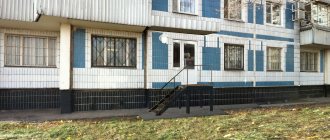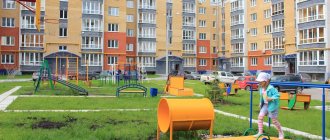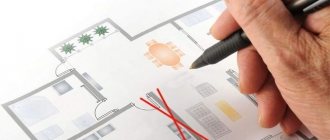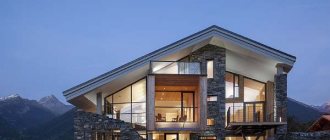Preparatory work
Before you begin drawing up a future site plan, you need to decide on the terrain itself, the nature of the relief, the shape of the land, the presence of any buildings, as well as other features of the area. For example, in rural areas there are a large number of streams and reservoirs, if one is present on your site, then you can use it correctly.
Plot with a stream
Please note several features of the location of the dacha:
- lowland - hill;
- presence or absence of a water source;
- wooded area - steppe.
Quite often it is necessary to add or remove soil, make blind areas for walls, and also make organized drains. Only with proper placement of buildings on the site can you make maximum use of the dacha plot and highlight all the zones.
Sometimes leveling of the area is required
To ensure that all the preparatory work is done correctly, it is best to assess the space and start from the ground.
- Relief: hilly, flat, with ravines or mountains. The layout of utility lines will depend on this indicator.
- Soil: clayey, humus, sandy. If you plan to equip a vegetable garden, you should increase the soil fertility by applying fertilizers. The set of plants for the garden and flower beds will depend on the acidity level.
- Shape and size of the territory: square, rectangular and elongated.
- Groundwater: If the level is high enough, consideration should be given to drainage and removal of water.
- Climatic conditions.
- Illumination.
Relief can be effectively played out
It is better to orient all large buildings and trees towards the north. This approach will reduce the influence of shadows, and the view from the house will be maximally illuminated throughout the day.
Landscape planning for a narrow and long area
A narrow and long area cannot be considered problematic. Whatever the configuration of the land plot, the design will not be simple.
Everything needs to be taken into account: the terrain, the occurrence of groundwater, the wind rose, orientation relative to the cardinal points, soil composition, proximity of urban objects, and many other factors.
It is not always possible to choose a plot of the desired shape - we may inherit it, or it is very important for us to build a house in a specific area, and we think about its shape last.
When purchasing a summer cottage, we often pay attention to its price and convenient location. Only after a while, when we start planning, do we think about whether a long plot is suitable for us.
Advantages and disadvantages of a narrow long section
Of course, if we are going to use most of the 5-acre plot for a vegetable garden, and it is long and narrow, and even oriented to the north, it will be difficult to solve the problem. But if the plot is large, or our acres are well lit, it will be easier to plan the plot.
The advantages of a long section include:
- It is easy to break it down into zones;
- The design of a summer cottage may not include a vegetable garden. But if you really want to plant at least a small piece of land with vegetables, it will be easy to fence it off so that the beds are not conspicuous;
- For fanatical lovers of vines or grapes, a long narrow plot can be a real find.
If planned correctly, every piece of land will have a use;
Disadvantages include:
- It is not always possible to build a house of the desired layout on a narrow plot;
- The fence enclosing land ownership cannot be high and dense, even if you strive for maximum privacy - it will simply block the access to light;
- The landscape design of a narrow area, even a very large one, does not provide for the presence of a large number of large trees, including fruit trees - they will shade and further conceal the space;
- If the site is located along the road, it will be difficult to achieve good sound insulation;
- The planning of a long section should be carried out by an experienced specialist.
Layout features
It should be noted that with inept planning, even the most advantageous configuration, with the most favorable location, can be turned into a dull space unsuitable for living. On the contrary, if it is properly designed, it will look so that no one will think of remembering what shape it is or whether it is well located.
Even if you have the necessary skills to arrange the site yourself, it is better to leave the design to a specialist. If the garden plot is very small and there is no extra money, use our advice.
Location of the house
In any land ownership, the main element is a residential building. If you are just about to build it, keep in mind that the best orientation of the end walls will be to the west and east.
Zones on the territory of the dacha
The layout of a summer cottage depends precisely on the zones that will be included here. Each individual case will have its own list, but you can consider the largest example and list of zones:
- residential;
- recreation;
- outbuildings;
- garden;
- garden.
Zones on the territory
Each of them should have its own area depending on the total area. So, if zoning is carried out correctly, the residential part should be up to 20%. If it is planned to build outbuildings, then this percentage should not exceed 15%. At the same time, the largest plot is allocated to the vegetable garden and garden - 75%. This approach will allow you to diversify your landscape design and fill it with a wide variety of flower varieties and plant species.
- The house is placed first. Most often, a central zone is allocated for it, but buildings are most often located somewhere in the depths. In an interesting and original way, they can be disguised with the help of decorative plantings that are not afraid of shadows.
- The place to relax should be the most comfortable and best. In this case, the nature of the zone can be arranged or scattered. Here you should not forget about the place for a children's playground.
- The garden should be well lit, so it should be given the sunny side. The shadow of buildings should not obscure the territory.
It is best to place the bathhouse and pool next to the fence, since when placed in the central part they will take up precious square meters.
Features of planning site landscape elements
There are some basic elements of the landscape of a summer cottage, each of which requires careful planning.
The primary object of development of any site is a residential building.
The planning of personal plots should begin with choosing the place where it is best to locate your main building - a residential building. The subsequent breakdown of the site is carried out depending on where the house is located.
If the plot was purchased in order to use it for growing garden crops, then its preferred location would be near the fence.
Thanks to this, the area allocated for growing sun-loving plants, which will give you lush flowering or a rich harvest, is expanding.
If a suburban plot of land was purchased in order to implement picturesque landscape solutions on it and relax in the lap of nature from the noise and bustle of the city, the residential building must be placed harmoniously so that it complements the design idea.
Shapes of plots
Rectangular plot
Options for planning a summer cottage can be very diverse, but almost everything will depend on the shape of the land plot. The most common type of plot is a rectangular shape, on which it is possible to implement a wide variety of solutions and ideas. There is also an L-shaped type of plot. It is quite complex, so you will need to think and think about where and how to place everything. The part that protrudes can be used as a place to relax or as a playground.
Triangular plot
On a triangular-shaped site, you can consider an asymmetrical approach when planning and dividing the territory. The emphasis should be on round elements:
- lawns;
- gazebos;
- bodies of water;
- flower beds.
Round flowerbed on a triangular plot
It is best to place outbuildings in remote corners.
Planning is a creative endeavor. Experts advise considering a wide variety of options, but not copying them completely, but making some changes.
Landscape design of a site of non-standard shape
Both the standard rectangular shape and the complex combination of bends and angles make it possible to successfully disguise unfavorable places and highlight successful ones. A garden of almost any shape has its advantages and disadvantages. Therefore, you can achieve the desired result in any case. You just need to wisely take advantage of the benefits that a non-standard shaped garden plot provides.
Originality of thinking
No matter how you decide to organize the space of your garden area, you should not make the perimeter the starting point that determines its future design. The design built along the fence not only visually reduces the space, but also emphasizes the existing irregular shape. Therefore, you should not plant narrow borders along the fence, leaving soil in the middle for the lawn.
Think backwards! Focus the viewer's attention on the open space, not on its border. The shape of the open space should be clearly defined and emphasized. When determining it, it makes sense to focus on the proportions and design of the house, which will help combine the garden and house into a single landscape project.
The use of similar building materials greatly facilitates this task.
For lawns, a round shape is usually chosen, or even two circles. You can also experiment with partially overlapping rectangles. Once you've got your open space figured out, you can start planning out the pieces to fill the voids.
With this approach, it is usually possible to divert attention from the non-standard shape of the garden plot and somewhat soften the boundaries of the available space. And by borrowing as details the trees of your neighbors’ gardens, which will be overlooked from the site, you can optically expand the space and divert attention from your own boundaries.
Creative rethinking of the space of a site of non-standard shape
Gardens are boring and uninteresting, in which you can see all the beauties without leaving your spot. With the exception of tiny plots, in any garden area it is necessary to plan at least two paths: the first to go out into the garden, and the second to return to the house. They don't have to be long and wide.
Let one of them cross an open space in some place, and let the other, lined with rough stones, lead around or indicate a place where you can “shortcut” the path. And let there be a lot of interesting things along the paths: containers or flower beds with flowers, interestingly shaped trees, a small pond.
All this will attract you, forcing you to move around the garden.
Elevation differences also help to divide the garden area into zones. This can be done either by terracing an existing slope or by artificially creating an embankment on a flat surface.
The contrast between shady and light areas of the garden helps change the mood in the garden. In addition, light, color and shadow contribute to the modification of space and give it a certain depth. Typically, light objects appear closer, while dark colors make objects appear optically further away.
The color black works real miracles: a fence or canopy painted in it almost disappears into space. In addition, black objects are an excellent background for plants, adding spectacular depth to the composition. Golden foliage, fragile branches or a single plant are stunningly beautiful against a black background.
Especially in the rays of the setting sun.
To visually enlarge the space, you should plan at least one place in the garden for a perspective view. And it is not at all necessary that the view be on the central path. Any clearly visible line is perfect for these purposes. And its best ending will be an accent visible in the distance.
Irregular shape of the plot
For various reasons, many household plots have very awkward shapes. There are many reasons for this: the boundaries of plots with alienation and annexation of land have changed over the years, the demolition of buildings, the completion of an existing house, and even the unusual shape of the building.
But landscape design is not only an art, but, in its own way, a science, and the practical application of existing knowledge helps to change the situation for the better.
Irregular garden plots encourage creative solutions to the available space, resulting in gardens that are much more interesting than a standard rectangular layout. Time passes, and the owners completely forget that they once considered their territory unsuccessful.
Square garden
It just seems that measuring and drawing a square-shaped area is very simple. There really are no problems with measurements. But in order to create something interesting on it, you will have to suffer quite a bit.
Spatial thinking in three projections at once, the use of correct shapes, clear lines and the right choice of plants help in this matter. It makes sense to experiment with hexagons and octagons.
They usually fit nicely into a square.
The predictability of a square shape can be overcome by zoning the site. True, this must be done carefully so that the artificial separation does not “hurt the eye.”
Plants, flexible and natural tools that soften the harshness of forms are perfect for this purpose. You can emphasize the height with the help of a tree, divide the area into zones with low partitions of hedges or tall grasses.
And plants climbing along the support will become a wonderful translucent screen separating the recreation area.
Correctly emphasizing levels and heights specifically on a square area becomes of paramount importance. If possible, you need to change the level in at least one garden area.
This could be a rising flower bed in the style of an alpine hill or a slightly raised pond.
Even a single step makes a big difference if its shape and location emphasizes the proportions and structure of the garden plot.
A few words about the patio
of patios also face the problem of properly organizing space . Often these patios have a square shape.
True, there are much fewer problems with them than with large squares. The owners do not need to figure out how to zone the available space, since it is small.
And the scale does not allow organizing an additional “room in nature”.
Modern design is well suited for arranging a patio.
The most successful designs manage to combine several elements at once: an entrance, a welcoming seating area, a fountain or pond, and dividing plantings that unite the garden into a single whole.
Some of the “highlights” of your patio can be corners with surprises, in which hidden sculptures, wicker chairs or plants, visible only from a certain angle.
Narrow and long garden
Perhaps the most common problem that property owners face is a narrow and long garden. It is enough to look out the window while driving through a suburb or along the streets of an old city, and you will find plenty of evidence of this. And if houses with terraces are located on such sites, the garden is often no wider than the base of the house.
The most common mistake homeowners make is turning the garden into an alley. This is actually very simple, especially when there is a direct road through the garden, fenced on all sides.
Rarely is a homeowner able to resist the temptation of the simplest space solution.
But we are talking about the garden as a place of relaxation! The challenge, then, is to make the garden a place where you want to linger rather than rush through it. And the proven zoning technique is perfect for this.
You need to imagine the garden as a collection of several zones, interconnected with the help of building materials or plants. The important point is the element of surprise. If, when moving to one area of the garden, the next one is completely visible, it is simply not interesting to move around the area. A winding path through thickets of evergreens that hide the boundaries of a narrow garden can remedy the situation.
Each garden area can be given its own shape.
You can choose a combination consisting of a play area, a flower garden, a herb garden, a barbecue area, a lawn, several fruit trees and a small pond.
All these zones should form a single whole, but in no case should they be united by straight lines of the road. Diagonals, curves and bends are much better at distracting attention from the parallel lines of property boundaries.
How to expand your boundaries
Owners of narrow and long gardens should take advantage of every opportunity to visually expand the boundaries of the site. This can be done with the help of a bench and an accent opposite, located at the end of the lawn or paved area standing across. You can also create the illusion of space using a mirror.
You should at least try to create a space with a view of objects located outside the site: neighboring trees, a landscape in the distance, or a simple piece of sky.
You can direct your gaze towards these details using pergolas and trees. Fences should also be covered with plants.
And the best option may be to visually combine with plants outside the site, because a fence lost in the thickets will create the feeling of a much larger territory.
Triangular garden
Fortunately, triangular-shaped garden plots are rare.
But in an attempt to combine areas of strange shape with wedge-shaped segments and tapering boundaries, left after the awkward placement of buildings, non-standard triangles often result, causing a lot of difficulties in the landscape design process.
The solution to the problem of a triangular garden is similar to gardens of other irregular shapes: organize zones with clearly defined shapes, using accents to keep attention within the area, and not at its borders and corners.
Owners of such plots must make optimal use of all available space along the longest border. This will visually enlarge the garden. One option is to orient the project to the shape of an irregular cross, in which the axes at right angles run across the longest and widest sides of the site.
And the plantings create the feeling that the site is long and wide everywhere, as at selected points. And there is no need to allow the garden to shrink into a wedge. Overlapping squares and circles of different sizes and elongated hexagons and octagons look good in triangular gardens.
To expand narrow areas, you can, again, use mirrors.
Small wide garden
In such a plot, neighbors' fences often put pressure on the owners. And the primary task in such cases is to create the illusion of depth in space. The techniques used to organize the space of long and narrow gardens also work with small, wide “brethren”.
You just need to rotate the plan 90°. You can borrow vegetation varieties to hide or remove boundaries from your neighbors. You can make the path leading to the far fence narrower, and this will change the perspective.
And changing colors, alternating open space and pergolas, light and shadow visually makes the path longer.
You can also distract attention from unsightly forms with the help of vertical objects. Tall buildings and plants contrasting with the horizontal lines at the far end of the garden visually deepen the area. And tall trees grouped around a low pond draw attention to the base of the site.
Of course, professional landscape designers know a lot of secrets that allow you to turn a non-standard shaped area into a garden of Eden. But putting into practice even this little knowledge will help keep attention on the accents of the garden, and not on its irregular or closely spaced boundaries.
Plan diagram
Once the important points have been identified and various layout options have been explored, you need to sketch everything out on a piece of paper. You can seek help from specialists, landscape designers who use special programs to develop the project. But to save money, a regular sheet of A4 paper and a pen (pencil) will be enough.
Sketching ideas
To sketch the plan, consider an example - a 10-acre dacha plot. It is best if you take a scale of 1:100 and a sheet of whatman paper of the appropriate size - a square of 50x50 cm. For convenience, it is better to arm yourself with a pencil and a ruler to line the entire sheet into a grid in increments of 1 cm. Next - a flight of fancy: arm yourself with colored pencils, clippings from magazines and felt-tip pens, with the help of which you can create a real collage.
When working with the diagram, you must take into account:
- location of the house taking into account all exits;
- places allocated for outbuildings and auxiliary buildings;
- rest zone;
- playground;
- paths;
- fence;
- flower beds, rock gardens and front gardens;
- bodies of water;
- engineering Communication.
When preliminary placing objects, you should select the optimal location that will suit the purpose.
Territory zoning
The division of the site into functional sectors must be carried out in advance in order to further proceed from the features of the development of the land plot.
In practice, there is a classic zoning scheme:
- Access area.
- Rest zone.
- Garden sector.
- Plot of outbuildings.
- Playground.
After compiling a list of the main sectors, it is necessary to display a schematic plan of elements for each zone.
Tips and tricks
So, as already mentioned, the main elements in the following categories should first be placed on the site:
- the basis is the house;
- additional buildings and outbuildings: summer kitchen, garage, well, barn, cellar and others;
- recreational buildings: terrace, patio, gazebo, playground, swimming pool and outdoor shower;
- garden and vegetable garden: flower beds, front gardens, beds for vegetables and root crops, greenhouses.
It is important to pay attention not only to their placement and shape, but also to decide on the materials that will be used during construction. Only in this case the site will achieve a harmonious garden style. The children's playground is no less important: when choosing a place, you should opt for the most visible area, so that the kids are always under the visual control of their parents.
The playground must be visible to parents
We also take into account the legal requirements regarding distance standards:
- from the house to the red line of the street - 5 m;
- from the house to the neighbor’s fence – 3 m;
- between houses made of stone - 6 m, wood - 15 m, mixed - 10 m;
- from the fence for a garden house - 3 m, buildings for animals - 4 m, outbuildings - 1 m, trees - 4 m;
- from the windows of the house to the neighbor’s utility parts – 6 m.
Standards for the location of buildings on the site
At the end of the article, a variety of examples of ready-made projects for planning summer cottages are given. Check them out and draw your own conclusions.
The best place for a garage is in the front yard. It is enough to select a small driveway for it, which will be made of strong and durable material.
What should the ideal site be like?
To summarize the issue of choosing a land plot for construction, we note the main important points.
- The shape is close to a square.
- In size - at least ten times the area of the house.
- It is located on a plain with a low groundwater level and a shallow aquifer depth.
- With good soil bearing capacity (usually sandy and sandy loam soils).
- At a minimum, it should be possible to connect to main gas and electrical networks.
- There should be no debris on the site in the form of old foundations, stumps, etc.
- It is desirable to have year-round access roads.
Of course, there are practically no sites that meet all the requirements. Therefore, choosing one or the other is a compromise; you will have to put up with some inconveniences and make a choice in favor of the characteristics that are most important to you.
There are other nuances associated with the selection and acquisition of land for individual housing construction, but they are of a documentary, legal nature and do not directly relate to issues of the possibility and feasibility of building a house on a particular area of land. We will talk about the legal intricacies of purchasing a plot of land for construction in the following publications.
Options for planning a summer cottage
Depending on the shape and area of the site, there are different variations and combinations of schemes. Let's look at the most common options.
Plot of 6 acres
Plan for 6 acres
6 acres is a very common option for a small dacha. This territory is presented in the form of 600 m2 of land, so it is most convenient to place the following buildings on it:
- House – up to 20 m2.
- Utility block (outdoor shower, toilet and shed) – 15 m2.
- Space for a car – 8 m2 (ideal placement 4x2 m).
- Recreation area and children's playground - 75 m2.
- Vegetable garden (includes a greenhouse, beds with vegetables and fruits) – 120 m2.
- Paths and paths – 42 m2.
- Shrubs, trees and flower beds – 320 m2.
The described section is located with its length along the road. The space allocated for the house is small, since it is a dacha in which people live only in the summer or come on weekends. When choosing fruit trees, you should pay attention to apple, apricot, cherry, pear, and plum. And among the shrubs, the favorites are currants, raspberries and gooseberries. The utility part is hidden behind the house as much as possible, but is also located at a distance from the recreation area.
The free area is planted with lawn grass, on which small architectural forms, for example, a fountain, are then placed.
Plot of 12 acres
12 acres
A garden area of 12 acres will allow you to place a larger number of objects and allocate additional space for recreation areas in comparison with the previous option. In this case, the layout will be distributed as follows:
- House with a spacious veranda – 150 m2.
- The utility part is 50 m2.
- Recreation area and playground – 200 m2.
- Vegetable garden and greenhouse – 200 m2.
- Garden plot – 550 m2.
- Paths and paths – 50 m2.
The principle of placement of buildings will be similar to the option of a plot of 6 acres, but in this case there is an additional opportunity for the implementation of various landscaping ideas. Thus, a large number of not only fruit trees and shrubs are connected, but also decorative ones. They can be planted around each object, as well as along paths.
In addition, additional square meters allocated for the recreation area will allow you to build a gazebo, swimming pool, and barbecue. It is very important to think about decorative lighting here, which will make spending time in the evening possible.
Plot of 15 acres
15 acres
First of all, we note that 15 acres is as much as 1,500 m2 of free territory, on which a wide variety of landscape combinations can be implemented. Most often, the plot has the shape of a rectangle 30x50 m or 25x60 m. There is enough space to include in the project everything necessary for comfortable and functional living not only in summer, but also in winter.
- Residential building with attic and veranda – 200 m2.
- Summer kitchen – 30 m2.
- Guest house – 50 m2.
- Bathhouse – 50 m2.
- Outbuildings – 70 m2.
- Garage with access for a car - 30 m2.
- The recreation area includes a gazebo, a children's playground, a barbecue and picnic area, as well as benches throughout the area - 300 m2.
- Decorative structures (fountain, artificial or natural pond, garden bridge, stone sculptures) – 100 m2.
- Vegetable garden – 200 m2.
- Flower beds and mixborders – 70 m2.
- Garden – 400 m2.
There are no special recommendations for such a site, so pay attention to the first and second options. Everyone will be able to realize any idea here, and even more than one - it’s enough to rationally weigh and develop everything so that everything fits and harmonizes very well with each other.
A country house should be surrounded by greenery, so a lot of time and effort is devoted to this stage. A large number of flower beds are planned and laid out, and a large front garden is set up in front of the house.
When independently developing a plan for your summer cottage, you need to take into account many nuances and points that will help you complete all the work correctly and efficiently. Please take note of the recommendations and advice given in the article, and also review the sketches of the site plans. As a result, you will be able to create the summer cottage of your dreams, where it will be comfortable to spend all seasons, regardless of weather conditions.
Optimal land plot size
When calculating the area of land, you should take into account the purposes for which it will be used.
If you plan to build a bathhouse on the site, plant a vegetable garden, install greenhouses, build a garage, sheds and other buildings, it is important to calculate everything so that they all fit not only without disturbing the comfort of the owners, but also the comfort of the neighbors, and also do not violate SNiP standards.
To determine the required area, it is recommended to draw up a detailed site plan with several options for the placement of buildings, planting, recreation areas and paths.
Experts believe that land with an area of 25-30 m2 is enough to create a recreation area with a children's playground, a gazebo and a swimming pool. For landscaping a country house and arranging a small vegetable garden, you will need a plot of up to 15 m2.
The calculation of the adjacent plot of land is carried out according to a formula that includes such parameters as the total area of the premises of the entire house (Sr) and the specific indicator of part of the land plot (Ypz), which is calculated according to SNiPs. The data for its calculation is taken exactly at the time of construction of the house.
Sn = Sr * Ypz
This calculation formula is suitable for land plots located around apartment buildings. For the private sector, there is no norm for such a territory and no calculation of the number of possible meters of adjacent territory.
Plot with a slope
The presence of uneven terrain provides for a classic zoning scheme, but changes are noted in the layout:
- The landscape design of the site involves the use of gabions for fences and terraces.
- To create flower beds, cascading types of flower beds are most often used.
Original alpine slides will be an excellent way to combine decorative finishing with the features of the relief.
Plot with insufficient area
Landscape designers advise owners of small plots of land to use this scheme:
- Divide the entire area into two equal parts.
- One of the parts should be allocated for the construction of a house, garage and access area.
- The second half should be evenly divided into the garden and household sectors.
If it is planned to build a playground, then it should be located closer to the residential building. For those who have not yet decided on the upcoming construction and zoning option, it is worth familiarizing yourself with the photo of the site layout.
Ready-made models and diagrams can be found in landscape design magazines.
Plan a plot of 6 acres
The classic “six hundred square meters”, which was the standard for a summer cottage back in Soviet times! It was for them that the basic principles of planning were developed, which modern landscape designers have embodied in 6 variants of schemes around which their creative fantasies are embodied.
- With a rectangular layout, all main functional areas are areas bounded by right angles. This is the most traditional, strict and geometrically verified layout, which allows you to easily place both buildings, including a residential building, and beds with flower beds. Unpretentious, simple and at the same time rational and convenient - it is not surprising that the rectangular layout of a plot of 6 acres is the most popular.
- A characteristic feature of the diagonal layout is not straight, but diagonal paths that go from to corner, dividing the area into separate zones. It is these paths that are the original axes along which the placement of all buildings, objects, and architectural forms is planned. Such a layout contributes to the visual expansion of the size of the site, an increase in the number of zones and their non-standard distribution. This layout is most often used when the owner wants to maintain a certain “diagonal” style, including the placement of the house.
- An irregular scheme involves a combination of ways to place different zones, the main thing is to achieve their harmonious combination. An example would be placing an entrance area with a parking lot or garage on that part of the site that faces the roadway, so it turns out to be a natural continuation of the entry area. On the path leading to the house, you can plant flower beds. Not far from the house, deep into the plot, you can arrange a recreation area, where, in the shade of trees, children's swings, benches and a gazebo for adults will harmoniously fit into the design; a swimming pool is also appropriate here.
- the utility zone in the farthest corner of your site; there will also be a place for a hygiene zone: a summer toilet and shower.
- A vegetable garden, fenced in such a way as to provide it with both ventilation and access to sunlight, will look good in the corner.
- The garden area can be combined with a recreation area, and if desired, an alpine slide can also be arranged there. Thus, with irregular planning, you can distribute zones at your discretion, without being tied to communications and regardless of the shape of the site itself.
Norms
- Somewhat similar to the irregular and curvilinear planning method , which is also called natural. It is based on the natural smoothness of lines and leaves paths connecting zones where they have already been trodden. This method eliminates sharp corners, and the transitions and turns of the paths are practically smoothed out, which gives the entire area a special aesthetics. You can plant shrubs and create flower beds on the sides of the paths, the main thing is to make sure that they do not grow onto the paths themselves.
- You can also plan an area of any shape along arcs and tangents, which, as in the previous version, rounds the corners, giving walks a special pleasure, and the territory itself - dynamics. In addition, a country house made in almost any architectural style will look good in such a scheme.
- All buildings and zones can also be placed in a circular (or semicircular) pattern, emphasizing the unusual shape with shrubs or low trees planted in the corners, which will “smooth out” the sharpness of the corners. When planning such a placement, inscribe a circle in the square of your site (just draw it with a compass) and divide it into sectors with rays. These rays will become the location of the future placement of objects. You can build the house itself in the center of your circle, and, if desired, along the beam line.
Are planning
Location on
Planning
How to properly arrange buildings on a summer cottage
In order to design a good recreation area on your property, there should be quite a lot of space between it and the roadway. This will avoid unwanted noise, odors, dust and views.
Option for placing buildings on the site
By planning the location of the recreation area in advance, you will receive a decorative barrier from the harmful factors of living in a densely populated area. If you want to ensure a high level of comfort on the territory, then the best method for this would be to plan the entire territory of the summer cottage into several main zones. Thanks to this, you will be able to find the best purpose for each piece of land.
If we talk about the exact amount of land for each zone for an area of 10-15 acres, then we usually use the following parameters:
- For the residential zone it is necessary to allocate at least 10% of the total area of the territory.
- Household buildings on this type of site should be small in size, up to 15%. This will help avoid unnecessary pollution of the entire area.
- A designated area for gardening can range in size from 50% to 75% of the total available area.
An example of zoning a summer cottage
When planning a dacha area, it is worth taking care of optimizing the space. It is best to allocate an area for a recreation area from part of the land previously allocated for the construction of a garden. There are 3 main types of site design:
- Front yard, residential building, back yard.
- The front yard and living quarters, that is, there is a deep planting of the house inside the territory.
- The location of the house is near the main entrance to the site, and the backyard is set deep into the site, which is why it remains hidden from prying eyes.
Whatever project option you choose, it is worth remembering that the front part of your territory is the most important. The front yard is the part of the site located near the main entrance.
Project of a site with a swimming pool and gazebo
As a rule, it is on this basis that the first impression is formed among guests and visitors to your home. The backyard is the area behind the house. It is on this territory that a recreation area, garden, vegetable garden, and outbuildings are usually located.
At the stage of planning a summer cottage, all grandiose ideas are considered, and an accurate calculation of the funds that can be spent on a particular object is made. After this, a decision is made on the feasibility of implementing the ideas. It is important to carefully and correctly plan the site, so that landscaping the site will bring joy and pleasure from living in this area.
What zones should be highlighted?
The layout of a summer cottage plot of 10 acres or any other area necessarily includes the following zones:
- Living sector. A terraced house and attached garage may be located in this area.
- Rest zone. A place for a recreation area is often allocated in the depths of the site, away from prying eyes.
- Vegetable garden area. A well-designed site layout will allow compact placement of beds for growing vegetables, fruit trees and berry bushes so that each crop has enough space.
- Economic zone. The area for the utility zone, where buildings for keeping pets are located, is allocated in the opposite direction from the recreation area.
A vegetable garden can also be beautiful and original; read about territory planning and design techniques:
A recreation area is equipped with a gazebo, a children's or sports ground, and a barbecue area. This place is often decorated with an artificial pond, original flower beds and other landscape design elements.
Regardless of the size of the allocated territory, the choice of site layout is based on the actual characteristics and wishes of the owner, for example:
Area of outbuildings
It is advisable to place all outbuildings together: shower, toilet, tanks for household waste, sheds for garden tools.
In addition, it is imperative to use a hedge to separate this sector from other zones. The following crops will help improve the sanitary and hygienic finishing and decorative design of this area:
- Evergreen conifers (thuja, yew, spruce).
- Spreading deciduous shrubs.
- Climbing plants: knotweed, virgin grapes, decorative ivy.
In addition, when planning a site, the availability of groundwater is taken into account in order to prevent soil erosion in the economic zone.
Project design of a triangular garden plot
Such territories have their advantages, since they are closer to natural lines, which makes it possible to plan the site dynamically and make the design unconventional. Here you can build several compositions that will look organic.
- Using diagonal solutions. The direction of the lines of your site itself suggests the directions - they should be used when laying paths. Let them also go along diagonals - this will visually enlarge small areas and make the composition unified, thereby helping to play up the unconventional shape of the territory. Make the paths wide, this will emphasize their direction.
- In addition, by placing the house and its entrance further from the entrance to the site, you will thereby separate these two zones, because your house will not be placed in a straight line from the central entrance, but diagonally. The same diagonal can be drawn when placing outbuildings.
- This will also make the entrance more convenient, which can also be equipped by maintaining an angle in relation to the road - then you will not have to make turns when entering your site.
- In front of the house you can set up a front garden, decorated in the same form. And you can combine straight and diagonal lines so that zoning will become even more effective, and decorate the areas connecting the zones with green spaces.
Triangular
- An absurd configuration is winding paths that will attract attention and distract it from the triangular shape of the site. If you also use corners to form zones, this apparent absurdity in design will become an original and effective solution. Repeat the broken lines in paving paths, using natural stones of various shapes or mosaic tiles, creating the most shapeless patterns from them. If you end up with corners at the boundaries of zones, decorate them with low bushes or trees.
- Natural lines - they are simply created for triangular areas. Use the features of the relief, simply “dissolving” the boundaries of both the entire site and its individual zones in the overall picture of the landscape - let them be streams, hills or ravines. This way you can easily decorate your site in a fashionable landscape style. With such a layout, it would be appropriate to gradually lower the height of the plants: from the borders planted with trees, move to the center of the site, first planting low-growing trees, then shrubs, and flowers closer to the house.
- Symmetry is a solution for those who traditionally see their plot in straight lines. In this case, it is necessary to place the main zones and buildings in them along a rectangle, and those triangular areas that remain along the edges can be occupied by green spaces and flower beds.
Great location
The main zones with a triangular layout remain unchanged: entrance, residential, recreation area, utility and gardening.
Site characteristics
To plan your yard, find out the basic information about it. This is one of the first tasks. There are many factors to consider to create a cozy, useful, safe yard.
It is best to transfer the idea to paper, preferably to scale. This will allow you to see the open space, distribute objects around the perimeter, and decide on additional buildings.
The ideal option is, of course, a 3D plan with visualization. Today there are many programs that place and draw various objects and take into account geography.
Plot sizes
The size of the plots determines the principles for placing objects on them. Let's look at the most common of them.
4 acres. The owners of such a courtyard cannot afford a garden or an expanse of vegetable garden, but proper planning will provide all the necessary buildings. For compactness, the house is built on two floors, with a wide porch - a place for relaxation, and auxiliary premises are attached to the house.
6 acres. Such yards require preliminary planning, and it is worth considering what activities will be a priority (dotting the backyard with a lawn or planting several trees, installing a gazebo or a children's slide). Small areas do not require a complex irrigation system; lighting will be provided by 3-4 street lamps around the perimeter.
8-10 acres. This quadrature allows you to satisfy many of the whims of the owner of the site: a good-quality vegetable garden or even a greenhouse, a garden of several types of trees, a pond, an open lawn, a gazebo and other buildings.
Drawing up a drawing diagram
The planning project must be drawn up after assessing the territory, choosing a site planning methodology and preliminary functional zoning of the area. The most important aspects that should be shown in the drawing:
- Total area of the territory.
- The location of the main buildings relative to each other.
- Mutual arrangement of functional zones.
- Detailed display of paths and hedges.
Such a detailed site planning scheme is necessary so that stage-by-stage construction work does not cause difficulties for the master.
Plan a plot of 10 acres: design plan ideas
- This is a large enough area to accommodate everything you see fit. Start planning by drawing on paper (preferably graph paper) those objects that already exist. By the way, you can also use Internet programs that help you create landscape design.
- Record objects in detail. A house with windows and an entrance, a vegetable garden with beds and paths between them. This will help you avoid mistakes when you start construction work.
- Find your bearings in which direction it is best to place what. Thus, it is wiser to fence off the territory located in the north by planting tall trees. It is also advisable to locate both residential and utility premises. Don't forget to identify and mark on your plan the corners that will be most shaded by recording the places of greatest shadow at different times of the day.
- Mark the places where the groundwater level is highest, then it will be easier for you to plan planting. For example, roses absolutely do not need excess moisture, and a tree planted close to communications can damage them with its roots over time.
- Living quarters, again, for safety reasons, are best placed on elevated terrain; it is also appropriate to place outbuildings . In low-lying areas, it is necessary to create a drainage system. Attention should be paid to ensuring that all distances required by safety rules are maintained, depending on the material from which the buildings are constructed, as well as complying with all requirements regarding distances to neighboring areas.
landscaping
Before planning the site, be sure to consider its shape. Thus, on an elongated territory, it is better to group objects into functional zones, leaving the central part free for movement. If the area is triangular in shape or similar to a trapezoid, then it is better to use corners and oblique lines with diagonals when placing separate zones on it. A square plot involves a central point - a residential building and a perimeter planted with trees, and in the shape of the letter "L" - it is advisable to use a protruding part in order to arrange a recreation area in it.
- With little tricks, you can visually enlarge the site by placing buildings in a diagonal order, and if the boundaries of the site have irregular outlines, they can be corrected by placing them in such “problem areas”, for example, flower beds. You can also “straighten” round contours.
- Functional zones can be located on a plot of 10 acres according to the standard principles given above. In any case, you will need to start from the location of the house, which should be, if possible, “removed” from the noise of the street and roadway. Next, plan the entry area, gardening.
Scheme
Distribution
With plantings
Divide into zones








